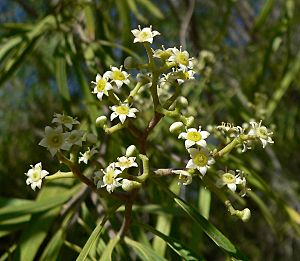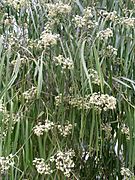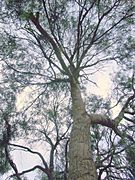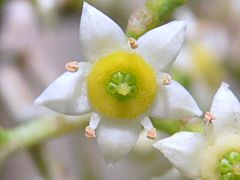Wilga facts for kids
Quick facts for kids Wilga |
|
|---|---|
 |
|
| Cultivated specimen, Springs Preserve | |
| Scientific classification | |
| Genus: |
Geijera
|
| Species: |
parviflora
|
| Synonyms | |
|
|
The Wilga, also known as Geijera parviflora, is a cool shrub or small tree found in the dry, inland parts of eastern Australia. It's part of the Rutaceae family, which also includes citrus trees! This plant is special because it's endemic to Australia, meaning it naturally grows only there. You can spot a Wilga by its droopy branches, long, narrow leaves, and small white flowers. After the flowers, it grows round fruits with a shiny black seed inside. People also call it the Australian willow, native willow, sheepbush, or dogwood.
Contents
What Does Wilga Look Like?
The Wilga can be a shrub or a small tree, usually growing about 8–10 m (26–33 ft) (26 to 33 feet) tall. Its branches and leaves often hang down, sometimes even touching the ground! Sheep love to munch on these lower leaves.
Leaves and Smell
The leaves are a shiny dark green. They are long and narrow, like a spear, measuring about 35–180 mm (1.4–7.1 in) (1.4 to 7.1 inches) long and 4–10 mm (0.16–0.39 in) (0.16 to 0.39 inches) wide. Each leaf has a small stem called a petiole, about 3–12 mm (0.12–0.47 in) (0.12 to 0.47 inches) long. If you crush a Wilga leaf, it gives off a strong smell!
Flowers and Fruit
Wilga flowers grow in loose bunches called panicles, which are about 40–70 mm (1.6–2.8 in) (1.6 to 2.8 inches) long. Each tiny flower sits on a short stalk, about 1 mm (0.039 in) (0.04 inches) long. The flowers have small green parts called sepals, about 0.8–1 mm (0.031–0.039 in) (0.03 to 0.04 inches) long, and white petals, about 1.5–2.5 mm (0.059–0.098 in) (0.06 to 0.10 inches) long. Some people say the flowers smell a bit stinky, while others think they smell like citrus! This smell helps attract insects to pollinate them.
Wilga trees usually flower from June to November. After flowering, they produce small, round fruits, about 4–5 mm (0.16–0.20 in) (0.16 to 0.20 inches) across. Each fruit holds one shiny black seed inside.
How Wilga Got Its Name
Taxonomy and History
The Wilga plant was first officially described in 1848 by an English botanist named John Lindley. He wrote about it in a book called Journal of an Expedition into the Interior of Tropical Australia, which was written by Thomas Mitchell.
The scientific name parviflora comes from a Latin word that means "small flowers." This name perfectly describes the Wilga's tiny blossoms!
Where Wilga Grows
Habitat and Location
Wilga trees prefer to grow in soils that have a lot of lime, like red clay or sandy soils. You'll often find them scattered in open woodlands, or sometimes in small groups.
They are mostly found in the inland areas of New South Wales and Queensland in Australia. You can also find them in south-eastern South Australia. They are quite rare in Victoria, only growing in a small area near Kenley in the north-west of the state.
How People Use Wilga
Useful Plant
Wilga is a very helpful tree in farming areas. It provides great shade for animals and is also used as fodder, which means food for livestock like sheep. Sheep especially love to eat the lower branches! It's interesting because some Wilga trees are eagerly eaten by sheep, while others are ignored. Scientists aren't sure why this happens, but they think it might have something to do with the soil.
Even though it grows slowly, Wilga is planted in Australia and other countries as a beautiful ornamental plant in gardens. It likes lots of sunshine and can handle a little bit of frost and dry weather, which is good for places with droughts.
Traditional Uses
Long ago, Indigenous Australians would chew the fragrant leaves of the Wilga to help ease toothaches.
Growing New Wilga Plants
It can be tricky to grow new Wilga plants from fresh seeds or cuttings. Experts suggest that cracking the hard outer shell of the seed can help it sprout more easily.
Gallery





